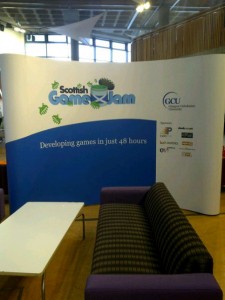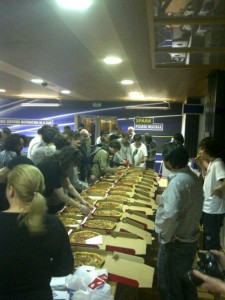 So what’s a Game Jam? Its a gathering (whether virtual or physical) of committed individuals who get together to create a game in a short time period. It can be run as a competition or just as a communal development event. It can take a day or a month. It can be made up of professionals or complete beginners (or a mix of the two) and the games that are created can sell millions of copies or disappear into creative limbo forever.
So what’s a Game Jam? Its a gathering (whether virtual or physical) of committed individuals who get together to create a game in a short time period. It can be run as a competition or just as a communal development event. It can take a day or a month. It can be made up of professionals or complete beginners (or a mix of the two) and the games that are created can sell millions of copies or disappear into creative limbo forever.
What’s a Global Game Jam? Its an event where lots of Game Jams are run concurrently to create a Global event; a kind of meta-jam. Communication between the Jams is done by social media, the Global Game Jam site and the hard work of the organisers of each event who pull together to create a Global Game Jamming community.
What’s a book? Its a written or printed work of fiction or nonfiction, usually on sheets of paper fastened…… You get the idea.
Jon Brady’s book focuses on the Glasgow portion of the Global Game Jam which took place last year in Glasgow Caledonian University. In Jon’s own words, “Over 100 game developers, artists and designers gather at Glasgow Caledonian University. Ahead of them, the Scottish leg of the Global Game Jam – 48 hours of exhausting, sleep-deprived but invigorating and adrenalin-fuelled hardcore game development. The theme? Extinction.”
 Game Jams are a peculiar but exciting new concept in games development, and the Scottish Game Jam showcases everything that is good about them. At CalmDownTom we were present for the event that this book chronicles and some of our site members even took part. I myself interviewed many of the team members and industry luminaries that were in attendance, and the best thing about Jon’s book is that it captures that amazing atmosphere of creativity, excitement and hard work that I remember from the event. Flicking through these pages, you can almost smell the programmer sweat, red bull and stale pizza. Its Jon’s ability to shine a light on the minutiae of the hard working teams environment that makes it such an evocative experience. For anyone who was in attendance, reading about this will trigger half-remembered vignettes that might otherwise be lost if this book hadn’t been written. For that reason alone I was glad to see it get to print.
Game Jams are a peculiar but exciting new concept in games development, and the Scottish Game Jam showcases everything that is good about them. At CalmDownTom we were present for the event that this book chronicles and some of our site members even took part. I myself interviewed many of the team members and industry luminaries that were in attendance, and the best thing about Jon’s book is that it captures that amazing atmosphere of creativity, excitement and hard work that I remember from the event. Flicking through these pages, you can almost smell the programmer sweat, red bull and stale pizza. Its Jon’s ability to shine a light on the minutiae of the hard working teams environment that makes it such an evocative experience. For anyone who was in attendance, reading about this will trigger half-remembered vignettes that might otherwise be lost if this book hadn’t been written. For that reason alone I was glad to see it get to print.
A Game Jam is interesting on two separate levels. Firstly, for gamers its fascinating to see the thought processes and amount of work that goes into creating a functioning game. The Scottish Game Jam allows the teams 48 hours, and this is a timescale that is challenging in the extreme. Games development is a time consuming process and by truncating it so much you put enormous pressure on a team to think fast, adapt to new challenges and solve problems as they encounter them. This leads to the second exciting dimension in a Game Jam: the human drama. The pressure and passion of the event can make or break friendships for good. Every decision seems like life or death, every small victory brings elation and every setback seems like the end of the world. Into this environment an author has a wealth of material and the challenge is to capture as much of this drama and excitement as they can before it fades away. As the teams disband and return to their regular lives – most of them off for some well earned sleep – the stories they take away are as valuable as the games they have created, and its the authors duty to capture these; to crytalise them and preserve them before they are gone forever.
 Jon wrote the book throughout the event and this approach is both a strength and weakness. He managed to capture many of the funny, interesting or just plain weird events of that weekend, but at the same time there’s not as much reflection as there could have been. As it is essentially a journal of the events of the Jam it can fall into tedium as the event hit its mid point and the authors energy and enthusiasm seems to ebb at the same time as the teams begin to fall asleep on the sofas. Although Jon’s discussion of the team dynamics are great, they are spread out between details of the logistics of planning and running the event. Its clear that he was involved in far more than just writing the book, but his exploits as a gopher running messages and helping with the organisation of the event don’t make for interesting reading and take him away from more interesting areas like the actual teams and their projects. The organisers would do well to let him focus on his writing next year.
Jon wrote the book throughout the event and this approach is both a strength and weakness. He managed to capture many of the funny, interesting or just plain weird events of that weekend, but at the same time there’s not as much reflection as there could have been. As it is essentially a journal of the events of the Jam it can fall into tedium as the event hit its mid point and the authors energy and enthusiasm seems to ebb at the same time as the teams begin to fall asleep on the sofas. Although Jon’s discussion of the team dynamics are great, they are spread out between details of the logistics of planning and running the event. Its clear that he was involved in far more than just writing the book, but his exploits as a gopher running messages and helping with the organisation of the event don’t make for interesting reading and take him away from more interesting areas like the actual teams and their projects. The organisers would do well to let him focus on his writing next year.
The writing itself is good for the most part and although you can tell that this is his first publication, it showcases a promising talent. There are miss-steps along the way. Apologising that your book may be poorly written in the introduction is a terrible faux pas. The modesty won’t win anyone over, and those who believed that the book WAS well written will now be convinced otherwise by the misplaced self-deprecation of the author. His confidence appears to increase as the book goes on though and after a chapter or two he seems to have found his voice. Meanwhile, his illustrations may be an acquired taste but I was a fan of these simplistic cartoons that will appeal to the internet-savy and those with a deeply held love of the “Forever Alone” meme’s. Footnotes spread throughout the text are amusing and I had at least one laugh out loud moment with the “caramel cupcake brownie” anecdote.
 The Game Jam is an event that attracts some truly interesting industry characters and as such Jon’s interaction with these characters are a high point. His late night discussion with the (brilliant) Phil Harris will bring a smile to the face of anyone who is lucky enough to know this industry veteran, and the text comes to life when the brilliant Romana Khan – who was the driving force behind the whole event – pops up. Other hard working team members and industry experts like Brian McDonald, David Farrell and Simon Lumb appear too, and we can only hope this years Games Jam has such a broad cast of maniacs, geniuses and superstars.
The Game Jam is an event that attracts some truly interesting industry characters and as such Jon’s interaction with these characters are a high point. His late night discussion with the (brilliant) Phil Harris will bring a smile to the face of anyone who is lucky enough to know this industry veteran, and the text comes to life when the brilliant Romana Khan – who was the driving force behind the whole event – pops up. Other hard working team members and industry experts like Brian McDonald, David Farrell and Simon Lumb appear too, and we can only hope this years Games Jam has such a broad cast of maniacs, geniuses and superstars.
The very best parts are the sections where Jon showcases the work of five chosen teams and charts their progress. He shows great insight in highlighting what is good and bad about their projects, highlighting potential problems throughout their planning stage into their implementation and design. For any prospective Game Jamer, these sections make for essential reading as they astutely describe some of the pitfalls that a project can fall into. If you want to learn from the failures of others, you should be ordering this book right now!
In the run up to the next Game Jam, this is an essential read for those who are competing. Meanwhile, for anyone with even a passing interest in the event its well worth seeking out too. If Jon writes another, I would hope he has less organisational commitments and more time to get to know the teams and soak up more of their stories. Despite these minor criticisms, I can’t help but recommend you run out and buy this now.
